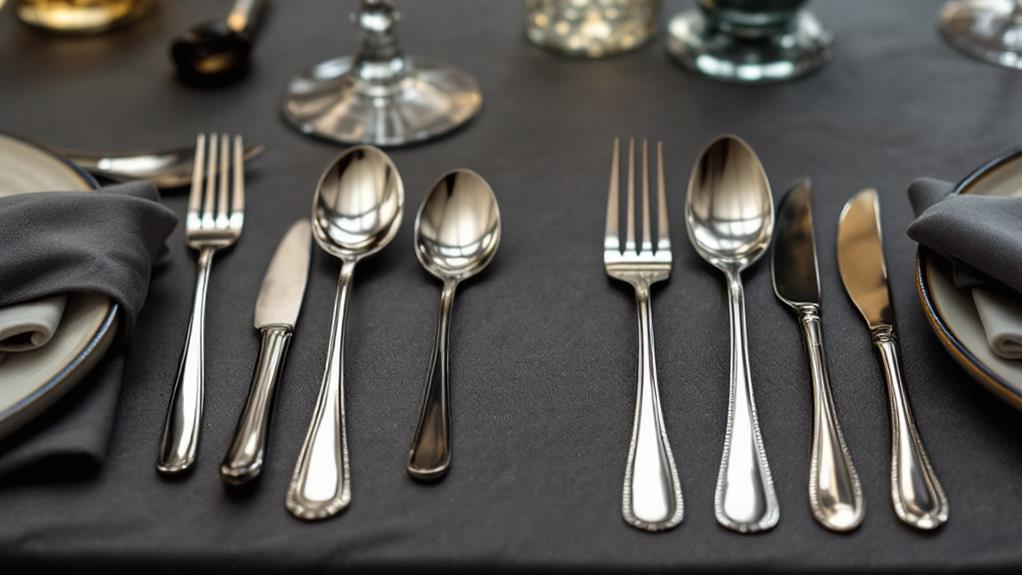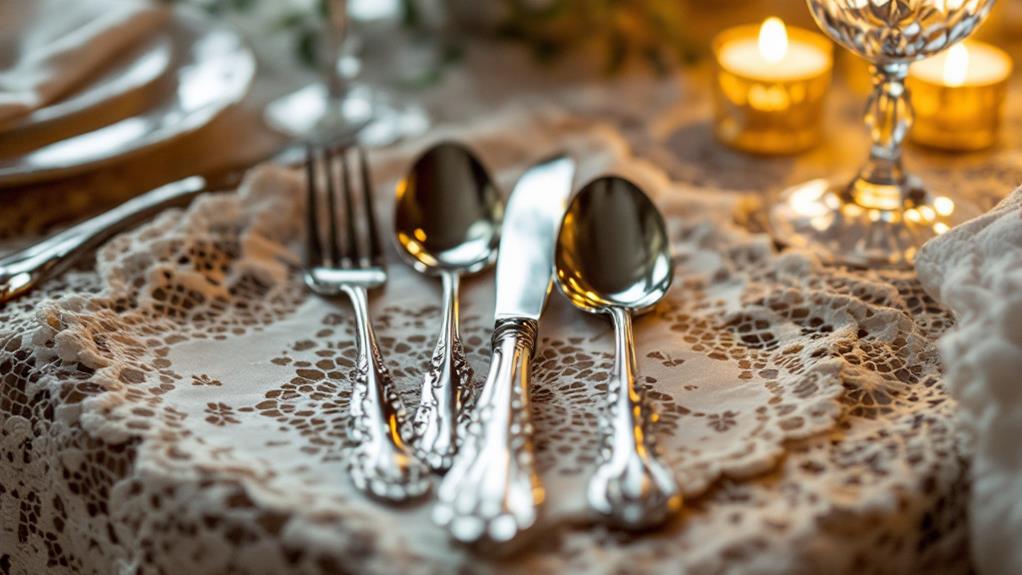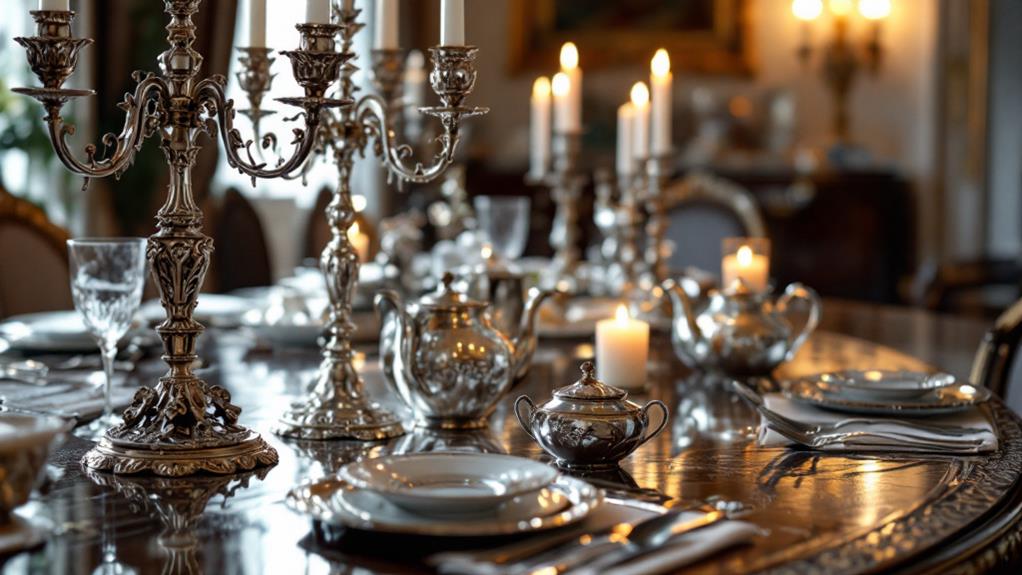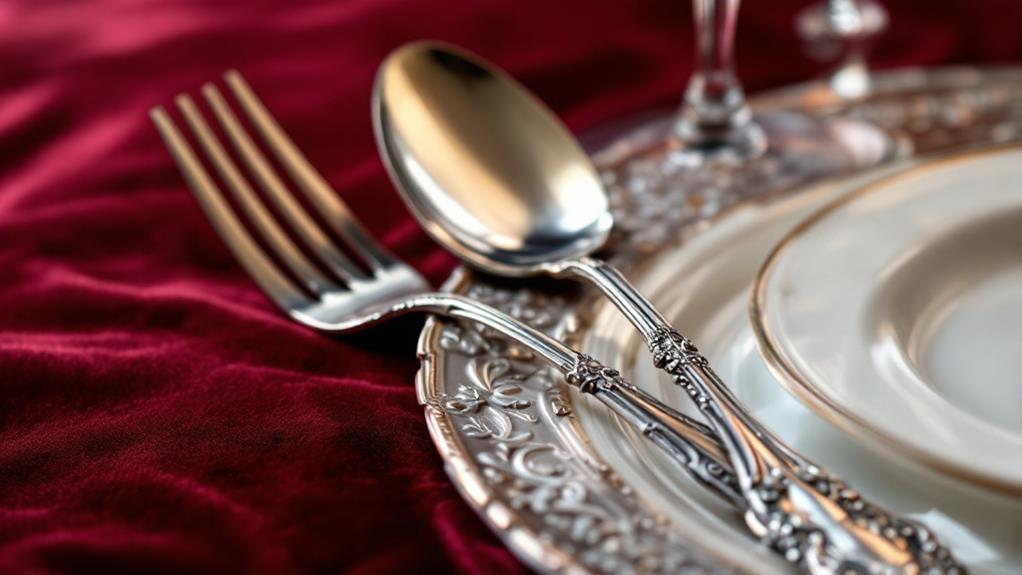The Origins of Silverware

The origins of silverware trace back to prehistoric times when humans used simple shells or wooden chips as eating implements. As civilizations developed, silver emerged as a preferred material for utensils due to its antibacterial properties and status symbol. Forks, initially used for cooking, gained popularity for eating in the 11th century. Spoons evolved from precious metals for royalty to pewter for the masses. By the 17th century, elaborate flatware services became fashionable, showcasing wealth and etiquette. The identification of new silver mines and manufacturing techniques led to more affordable and widespread use of silverware. There's much more to uncover about this fascinating expedition through dining history.
The Evolution of Eating Utensils
The odyssey of eating utensils spans millennia, reflecting humanity's ingenuity and changing social norms. You might be surprised to learn that prehistoric people used simple shells or wooden chips as eating implements. Forks, initially used for cooking in ancient civilizations, only became popular for eating much later.
In the Middle Ages, you'd find spoons made of precious metals gracing the tables of royalty and the wealthy. The 14th century saw pewter spoons becoming affordable for the general population. Forks, however, had a more controversial introduction to Western culture. When a Greek niece of the Byzantine emperor used one in 1004, it was considered scandalously decadent.
As eating habits evolved, so did utensils. Forks gradually gained acceptance in Italy and France, while Americans developed a unique "zig-zag" eating method using spoons and knives. By the 1850s, forks were well established in the United States. The ongoing evolution of eating implements is evident in the spork, a hybrid utensil that's been around for at least a century. From humble beginnings to silver forks, the history of eating utensils mirrors our cultural development.
Silver's Historical Significance
Silver's historical significance extends far beyond its aesthetic appeal. Throughout the history of Western civilization, silver has been a symbol of wealth, power, and status. From pre-historic times, it's been used by wealthy families, royalty, aristocracy, and clergy to showcase their prominence in society.
You'll find that silver has been revered as the "noblest" and "queen of metals" due to its unique properties and versatility. Its antibacterial qualities have made it an essential material for health and hygiene, leading to its widespread use in coinage, silverware, and jewelry. As you investigate silver's history, you'll uncover its association with mystical and protective powers, with references in ancient texts like the Bible suggesting its efficacy against mythical creatures such as werewolves.
The development of silver alloys further expanded its applications and significance over time. These alloys provided increased strength and durability, making silver even more substantial in various industries. As you examine the origins of silverware, you'll see how silver's historical importance has shaped its use in dining implements, reflecting its enduring legacy as a precious and practical metal.
Early Silversmithing and Production
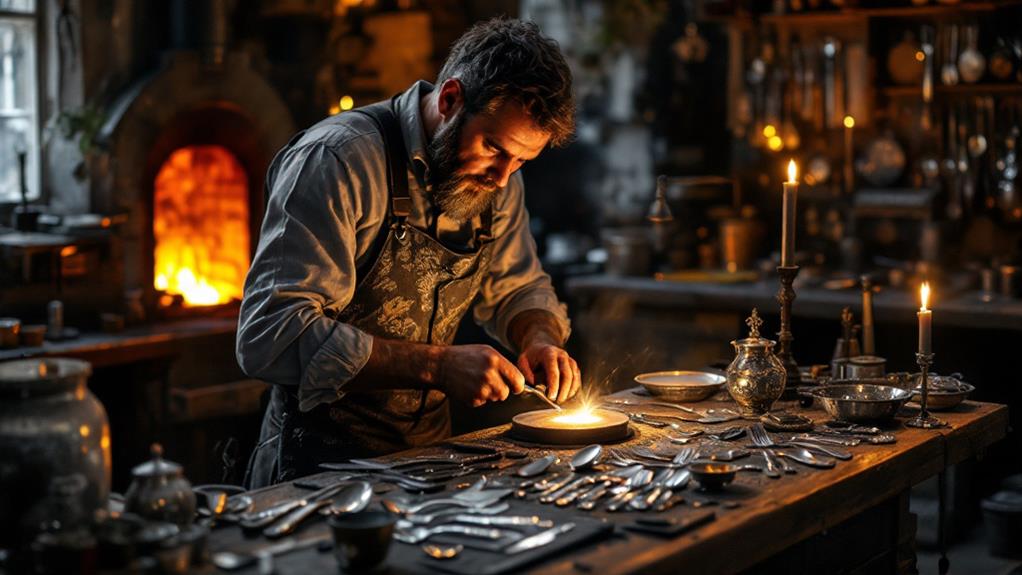
From as far back as 2500 BC, silversmithing has played an essential role in shaping economies and cultures. You'll find that ancient Greek and Roman economies heavily relied on silver coins, showcasing the metal's importance. The Phoenicians even used silver to weight their anchors in Spain, demonstrating its versatility.
As time progressed, central Europe became the hub of silver production during the Middle Ages. However, it wasn't until Central and South America took the lead that silver production truly flourished, dominating the industry until the 18th century. This period saw significant advancements in silversmithing techniques, long before the invention of stainless steel.
To guarantee quality and standardization, various silver standards were established. German 800/1000, British sterling 925/1000, and Britannia 958/1000 became recognized purities. Hallmarks indicating quality, location, and maker were introduced, becoming essential for worldwide recognition. These standards were pivotal for maintaining silver's value, even in the courts of monarchs like King Louis XIV. The introduction of assay offices further solidified the significance of these standards, confirming that silverware and other silver products met the required purity levels.
Hygienic Benefits of Silver
While silver's aesthetic appeal and economic importance drove its popularity, its hygienic properties truly set it apart. You might be surprised to learn that silver has been used for its antibacterial properties since ancient times. The Phoenicians, for instance, used silver vessels to purify water, taking advantage of its ability to kill microorganisms.
Silver's hygienic benefits extended beyond water purification. Sailors uncovered that placing silver coins in milk could prevent spoilage during long expeditions. This natural antibacterial quality made silver an ideal material for tableware and kitchenware, especially before modern sanitation and refrigeration methods were available.
You'll find that silver utensils, flatware, and dishware were highly prized not just for their beauty, but for their ability to inhibit the growth of bacteria and microbes. This inherent property contributed enormously to silver's widespread use in households throughout history. By choosing silver for your dining needs, you weren't just making a statement of wealth or taste; you were also safeguarding your family's health. The antimicrobial effects of silver made it a preferred choice for those who could afford it, combining luxury with practicality in everyday life.
Silver Purity Standards
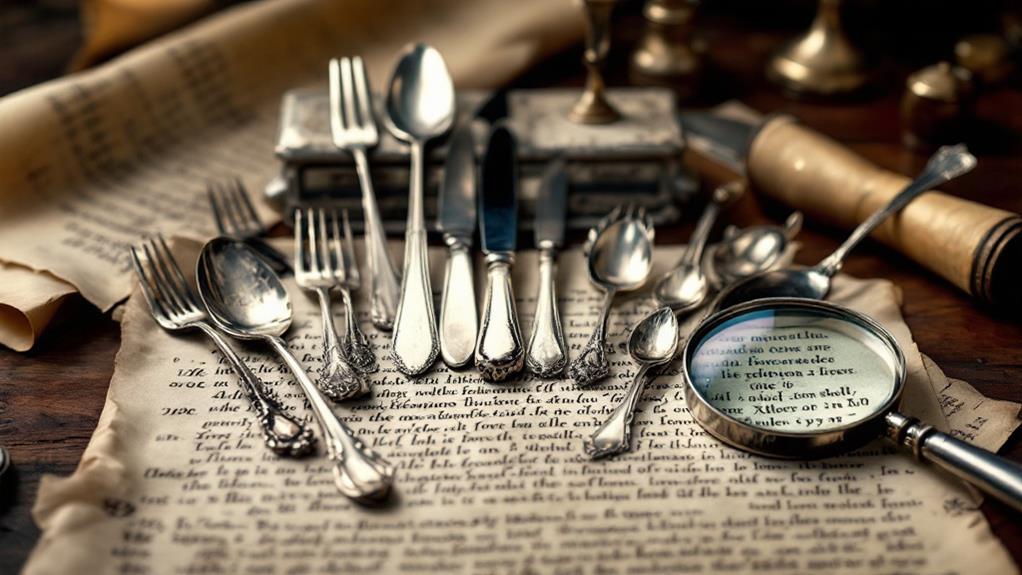
Purity standards played a vital role in the development and regulation of silver products. As you investigate the world of silverware, you'll find that different materials and regions have their own unique silver purity standards. For instance, German silver is graded at 800/1000 pure silver, while British sterling silver boasts a higher purity at 925/1000. If you're looking for even greater purity, Britannia silver stands out at 958/1000.
You'll notice that silver purity standards weren't always uniform. In the 18th and 19th centuries, American silver manufacturers used independent purity standards before standardization took hold. To guarantee quality and authenticity, hallmarks became essential worldwide, indicating the silver's purity, origin, and maker.
The system of standardizing silver purity evolved over time to maintain consistency across the industry. You'll find that some regions were known for exceptional quality, like Newcastle silverware in the 18th and early 19th centuries, thanks to their distinct solder. As you investigate the history of silverware, you'll see how these purity standards have shaped the industry and continue to influence silver production today.
Rise of Flatware Services
As the Industrial Revolution altered society, the rise of flatware services brought a new dimension to dining experiences. You'd find that keeping large sets of silverware became common, metamorphosing the dinner table into a theatrical stage. The Industrial Revolution didn't just change manufacturing; it revolutionized how you dined.
Knives and forks weren't just utensils anymore; they became works of art. Decorative elements like leaves and scrollwork adorned silverware, with patterns like Tiffany's Chrysanthemum becoming coveted status symbols. You'd see specialized utensils like asparagus tongs and sardine forks appearing, catering to the growing diversity of dining rituals.
As the middle class emerged, strict rules governed everything from seating arrangements to beverage placement. The nobility, keen to maintain their distinction, created even more elaborate dining rituals. You'd hear the philosophy that "Animals eat; only man dines" echoing through dining rooms.
Owning the latest flatware patterns became a symbol of status, with the middle class hosting banquets to showcase their silverware. The dinner table had become a battlefield of social climbing, where your choice of cutlery could make or break your reputation.
Material Innovations and Mass Production
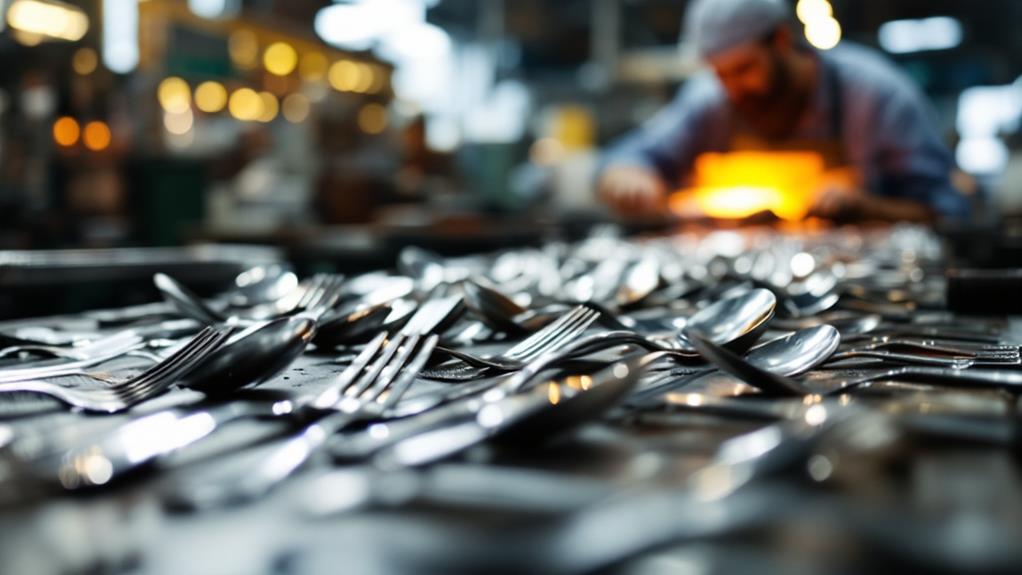
The Industrial Revolution ushered in an era of material innovations and mass production that altered the silverware industry. You'll find that silver, used to make flatware since the 17th century, became more accessible due to new discoveries and manufacturing techniques. The Comstock Silver Mine's detection in 1859 significantly impacted silver's affordability, allowing for increased production of silverware in the United States.
In Great Britain, German silver emerged as a popular alternative for flatware production. This alloy of copper, nickel, and zinc offered a cost-effective option for manufacturers and consumers alike. The widespread availability of silverware led to a cultural shift in dining and entertaining practices. You'd now see:
- Elaborate table settings showcasing luxury
- Diverse flatware patterns reflecting the latest designs
- Silverware becoming a status symbol for dinner party hosts
- Renowned makers like Tiffany & Co. setting trends in flatware
As industrialization progressed, mass production techniques allowed for greater output and variety in silverware. This democratization of luxury items meant that you could now own and display fashionable flatware sets, participating in the art of dining that had once been reserved for the elite.

